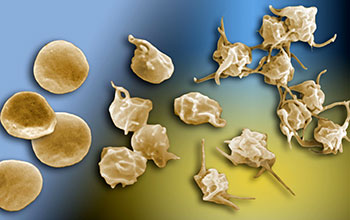Multimedia Gallery
How platelets naturally form unobtrusive clots (Image 2)
Activated platelets with platelet extensions called filopodia. The first view of the physical mechanism of how a blood clot contracts at the level of individual platelets is giving researchers a new look at a natural process that is part of blood clotting. A team of researchers from the Perelman School of Medicine at the University of Pennsylvania describes how specialized proteins in platelets cause clots to shrink in size. [See related image Here.]
More about this image
The first view of the physical mechanism of how a blood clot contracts at the level of individual platelets is giving researchers from the Perelman School of Medicine at the University of Pennsylvania a new look at a natural process that is part of blood clotting.
To learn how a clot contracts, the Penn team imaged clots (networks of fibrin fibers and blood platelets) using an imaging technique called confocal light microscopy. The natural process of clot contraction is necessary for the body to effectively stem bleeding, reduce the size of otherwise obstructive clots, and promote wound healing.
The physical mechanism of platelet-driven clot contraction they observed is already informing new ways to think about diagnosing and treating conditions such as ischemic stroke, deep vein thrombosis, and heart attacks.
This research was supported in part by the National Science Foundation (grant DMR 15-05662).
To learn more about this research, see the NSF News From the Field story Video of blood clot contraction reveals how platelets naturally form unobtrusive clots. (Date image taken: Unknown; date originally posted to NSF Multimedia Gallery: Feb. 27, 2018)
Credit: Oleg V. Kim, Rustem I. Litvinov, Mark S. Alber and John W. Weisel
See other images like this on your iPhone or iPad download NSF Science Zone on the Apple App Store.
Images and other media in the National Science Foundation Multimedia Gallery are available for use in print and electronic material by NSF employees, members of the media, university staff, teachers and the general public. All media in the gallery are intended for personal, educational and nonprofit/non-commercial use only.
Images credited to the National Science Foundation, a federal agency, are in the public domain. The images were created by employees of the United States Government as part of their official duties or prepared by contractors as "works for hire" for NSF. You may freely use NSF-credited images and, at your discretion, credit NSF with a "Courtesy: National Science Foundation" notation.
Additional information about general usage can be found in Conditions.
Also Available:
Download the high-resolution JPG version of the image. (753.6 KB)
Use your mouse to right-click (Mac users may need to Ctrl-click) the link above and choose the option that will save the file or target to your computer.



